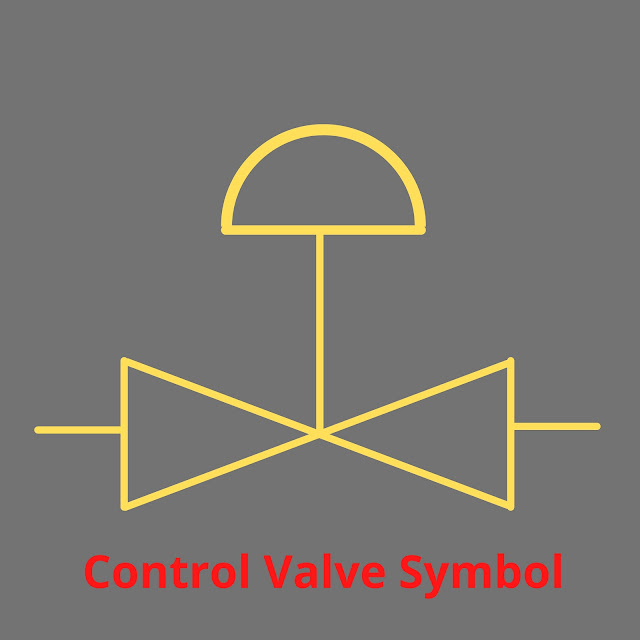A control valve is a device that controls, mixes, or closes
the process temperature, pressure, flow, etc. It is called a control valve. Or
process line variable restriction is called control valve. There are two main
and major types of control valves.
Control Valve
A control valve is a device that controls, mixes, or closes the process temperature, pressure, flow, etc. It is called a control valve. Or process line variable restriction is called control valve. There are two main and major types of control valves.
- Linear Motion Control Valve
- Rotary Motion control valve
Control Valve Parts
and Terminology
 |
| Control Valve parts |
Diaphragm Case
It is considered the backbone of the control valve and is the
most important member of the control valve. It consists of the upper and lower
sections of the control valve. It is used to support the diaphragm.
Diaphragm Plates
This plate is attached to the diaphragm to transmit the
force to the equator.
Actuator Spring
It moves with the movement of the spring diaphragm. And it
works on the principle of resting force.
Spring Seat
It is a plate that holds the spring in position. And it
provides a smooth surface for contacting the spring adjuster.
Spring Adjuster
It usually has a wide fitting above the actuator stem or
inside the yoke. Which adjusts the compression of the spring.
Yoke
This is the part that connects the body of the actuator and
the control valve. Spring fits inside this yoke. Attached to the valve's travel
indicator and scale yoke.
Travel Indicator
It is a pointer attached to the stem connector. This
indicates travel with the valve plug.
Travel Indicator
Scale
This is a graduated scale that is attached to the yoke. And
it shows valve travel.
Packing Box
It is part of a bonnet assembly. According to the process,
glands are inserted in it which seal the stem from all sides and do not allow
the process to leak out of this path.
Bonnet
This part is mounted on the body of the control valve.
Cage
It is a cylindrical trim element. It guides the movement in
a straight line with the valve seal rings in the valve body.
Valve Plug
It is a moving part that provides variable restrictions in
the port.
Seat Ring
It is usually a round plate with a hole in the middle.
Actuator Stem
It is a rod that is attached between the diaphragm plate and
the valve plug and connects them.
Characteristics of
Control Valve
Much depends on the flow characteristics of the valve, the
design of the valve, and the trim material. That is, when the actuator receives
the signal, how much the control valve plug travels from its seat ring and how
much flow it keeps dropping? When the valve moves through the plug actuator,
the path to the flow is greater.
How many types of
Control Valves?
There are two types of control valves.
- Linear Motion Control Valves
- Rotary Motion Control valves
Generally, the following features are inherent to control flow.
Characteristics
- Linear Flow Characteristics
- Equal Percentage Flow Characteristics
- Quick Opening Flow Characteristics
Linear Flow Characteristics
The flow rate in the control, which has linear flow
characteristics, is directly proportional to the travel of the valve plug. For
example, if the valve plug travels 50%, the flow rate will be 50%. This type of
control valve is most commonly used where constant gain is required.
Equal Percentage Flow
Characteristics
In a control valve with this feature, when the wall plug
travels uniformly, the flow rate will change very little, that is when it is
close to the off position. Similarly, if the plug travels more, the flow rate
will also change a lot. That is, it will be close to the full ON position. For
example, if the plug travels from 20% to 30%, the flow rate will change from 4%
to 6%. And if the plug travels from 80% to 90%, the floor rate will change from
47% to 70%.
Quick Opening Flow
Characteristics
In the control with quick open flow features, the flow rate
changes as much as the valve plug travels very little. Conversely, if the valve
plug travels maximum, the flow rate changes very little. For example, if the
plug travels 110%, the floor rate will change by about 40%. And if the plug
travels from 80% to 90%, the flow rate changes from 77% to 95%.
Working Principle of
Control Valve
Pneumatic Actuator
Pneumatic actuators require air or signal to produce a
controlling process. The actuator takes the pneumatic signal force from its
upper part. It then divides this signal into diaphragms. And then the diaphragm
puts pressure on it. This is how the control valve gets stroked.
Devices that receive an electronic signal and run on a
motor.
The control valve is a device that operates automatically. It is
mostly used for pressure. The control valve operates with the help of a special
part called a valve plug. This part is connected to the stem. And the stem is
attached to the actuator.
Symbol of Control Valve
 |
| Control Valve Symbol |
- What is Control Valve
- Parts of Control Valve
- Types of Control Valve
- Characteristics of Control Valve
- Diagram of Control Valve
- Symbols of Control Valve
- Working Principle of Control Valve
Thanks For Reading.
Website: www.factsaboutworlda2z.website